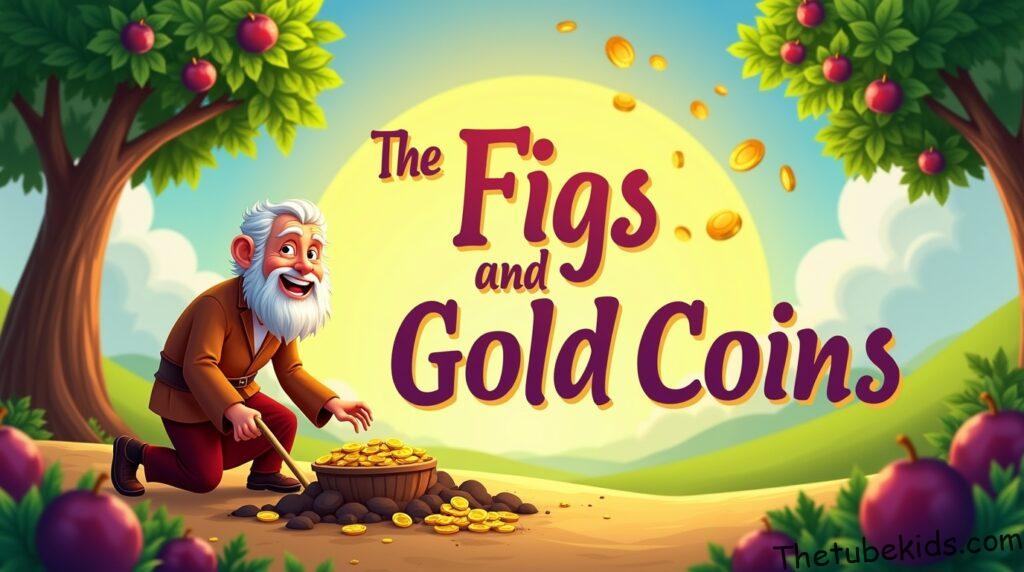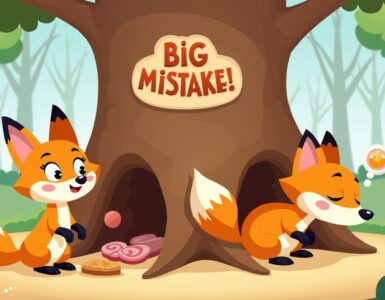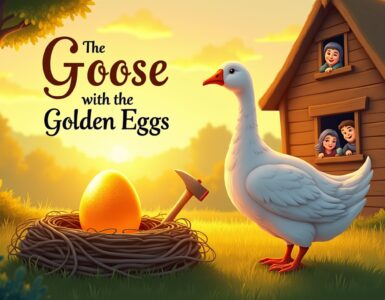Short Stories:
Once upon a time, there lived a wise and witty old man. He was so courageous and fond of nature. He celebrated his 100th birthday with his entire family. He had an amazing habit of planting a tree every year on his birthday. He used to plant a variety of flower bearing trees and fruit bearing trees. He was having a massive garden in his home. To celebrate the century, he planted a fig plant, his most favorite fruit.
The emperor who passed by his home was surprised to see this old man planting a fig tree. He asked his soldier to bring the old man to his court and enquired him!
‘ Dear old man, I was pleased and surprised as you were planting a fig tree! I wish you could have planted the fig tree when you were young. I guess you are now in your 90s and there is no hope that you shall taste the fruits from this tree ’
The old man replied, ‘My Lord, yes I knew it. I’m 100 years old now. I just planted the fig tree to celebrate by 100th birthday. And this is not the first tree I’m planting. I have planted more than 1000 trees in my whole life! I still have faith and hope that I shall live for a minimum of 10 years to taste the fruits borne by this tree after a decade. If not, I will let my tree to be enjoyed by my family! ’
The emperor was happy and hugged the old man. He said, ‘You are such an adorable person. Just come back to me if you are alive after years with a basket of figs. I would love to see you again!’
The old man thanked the emperor and left the place.
After a decade, the fig tree started to ripe fruits. The old man was happy and tasted the first ripen fruit. It was very delicious. The old man recalled the king’s words and picked the choicest fruits, filled a basked and carried to the palace.
The king was informed that an old man came with a basket of figs. The king recalled the words he uttered to the old man and happily welcomed him. He enjoyed the figs provided by the old man. The king ordered his minister to fill the basket with gold coins and asked his soldiers to drop the old man to his home. The old man was happy!
Hard work and hope will always be honored.
More: Short Stories: The Goose with the Golden Eggs – Best Bedtime Stories for Kids

Short Stories The Figs and Gold Coins – Timeless Tales of Wisdom
Short Stories The Figs and Gold Coins represent a fascinating collection of narrative gems that delve into human nature, morality, and the pursuit of happiness. These stories, often attributed to classic folklore or modern interpretations, use simple yet profound scenarios to impart life lessons. Through the symbolic use of figs and gold coins, they explore themes of temptation, greed, and redemption, making them enduring favorites in literary circles. This article examines these tales in depth, uncovering their origins, themes, and relevance today.
The Origins and Background of Short Stories The Figs and Gold Coins
The world of literature is enriched by stories like Short Stories The Figs and Gold Coins, which have captivated audiences for generations with their allegorical depth and moral undertones. These tales, though simple in structure, draw from a rich tapestry of cultural and historical influences, making them timeless. They serve as mirrors to society, reflecting the eternal struggle between desire and virtue. Before diving into their core elements, it’s essential to understand how these stories emerged and evolved, providing context for their enduring appeal.
Historical Context of the Stories
Short Stories The Figs and Gold Coins likely originated in ancient oral traditions, possibly from Mediterranean or Middle Eastern folklore, where figs symbolized abundance and gold coins represented wealth. In historical terms, figs were a staple in ancient diets, often associated with prosperity in texts like the Bible, while gold coins have been universal symbols of economic power since antiquity. This background sets the stage for narratives that critique materialism.
The first story, “The Figs,” tells of a traveler who discovers a tree laden with ripe figs, only to face moral dilemmas about sharing or hoarding the fruit. This tale may have roots in Greek myths, where fruits often represented forbidden knowledge or temptation, similar to the Garden of Hesperides. Meanwhile, “Gold Coins” narrates the tale of a poor man who finds a bag of gold but must navigate the consequences of sudden riches, echoing themes in Aesop’s fables or Arabian Nights.
As these stories transitioned from oral to written forms, they were adapted by various cultures, including during the Renaissance when moral tales gained popularity in Europe. Authors like Hans Christian Andersen or the Brothers Grimm might have drawn inspiration from similar motifs, adapting them to convey ethical lessons in an era of social upheaval.
Cultural Influences Shaping the Narratives
Short Stories The Figs and Gold Coins are steeped in cultural symbolism that varies by region. In Eastern traditions, figs might represent enlightenment or spiritual growth, as seen in Sufi poetry, whereas in Western literature, they could symbolize decay or overindulgence, as in Shakespeare’s works. This duality adds layers to the stories, making them adaptable to different audiences.
The narrative of “The Figs” often incorporates elements of Eastern philosophy, where the fruit’s sweetness tempts the protagonist to reflect on impermanence, much like Buddhist teachings on attachment. Conversely, “Gold Coins” draws from capitalist critiques in Victorian literature, where sudden wealth leads to moral corruption, as explored in Charles Dickens’ novels.
These influences have ensured the stories’ global reach, with adaptations in children’s books, films, and even modern self-help literature. Their ability to transcend cultural boundaries highlights universal human experiences.
Modern Adaptations and Interpretations
In contemporary times, Short Stories The Figs and Gold Coins have been reimagined in various media, from animated shorts to theater productions. Modern adaptations often emphasize psychological depth, using the stories to discuss mental health or environmental issues. For instance, “The Figs” might be portrayed as a commentary on sustainable living, urging audiences to consider the impact of overconsumption.
Filmmakers have used visual effects to enhance the symbolic elements, such as golden hues for the coins to represent greed’s allure. Interpretations in self-help books link the tales to personal development, suggesting that the figs’ fleeting nature teaches mindfulness, while the gold coins warn against the pitfalls of materialism.
This evolution keeps the stories relevant, as new generations reinterpret them through lenses like feminism or environmentalism, ensuring their place in modern discourse.
Key Themes in Short Stories The Figs and Gold Coins
At the heart of Short Stories The Figs and Gold Coins lie profound themes that resonate across time, exploring the complexities of human desire and ethics. These narratives use everyday symbols to unpack larger philosophical questions, making them more than mere tales. They challenge readers to reflect on their own lives, prompting a deeper examination of morality, greed, and the pursuit of fulfillment. By delving into these themes, we can appreciate how the stories continue to influence contemporary thought and behavior.
More: Short Stories: Love and The Time Story
The Symbolism of Greed and Temptation
Short Stories The Figs and Gold Coins masterfully employ symbolism to illustrate greed’s destructive power, with the figs representing immediate, sensory temptations and the gold coins symbolizing long-term material desires. In “The Figs,” the protagonist’s initial joy at discovering the fruit quickly turns to obsession, highlighting how temptation can blind individuals to ethical considerations and lead to isolation.
This theme is further explored through the characters’ internal conflicts, where the allure of the figs forces a confrontation with personal values. One character might rationalize hoarding the fruit, only to face consequences like spoilage or regret, emphasizing that unchecked greed often results in loss. The story uses this to critique consumerist societies, where instant gratification overshadows sustainable choices.
In contrast, “Gold Coins” delves into the temptation of wealth, showing how the protagonist’s discovery leads to paranoia and broken relationships. The coins, initially seen as a blessing, become a curse, illustrating that material wealth without moral grounding can erode one’s humanity. This narrative arc serves as a cautionary tale, urging readers to prioritize intrinsic values over extrinsic rewards.
Moral Lessons and Ethical Dilemmas
Ethical dilemmas form the backbone of Short Stories The Figs and Gold Coins, presenting characters with choices that test their integrity. In “The Figs,” the dilemma arises when the traveler must decide whether to share the fruit, posing questions about community versus self-interest. This forces readers to consider how ethical decisions impact broader societal structures.
The stories’ moral lessons are delivered through consequences, such as the traveler’s loneliness after choosing greed, which underscores the importance of empathy. “Gold Coins” amplifies this by showing the protagonist’s ethical downfall, where hiding the wealth leads to guilt and eventual exposure, teaching that honesty fosters true security.
- Bulleted list of key moral takeaways:
- Greed leads to personal isolation and regret.
- Ethical choices promote long-term happiness and relationships.
- Material wealth is transient, while moral integrity endures.
- Sharing resources builds community and personal fulfillment.
These lessons remain pertinent, offering guidance in an era of ethical ambiguity, from corporate greed to environmental exploitation.
Relevance to Contemporary Society
Short Stories The Figs and Gold Coins hold a mirror to modern society, where themes of temptation and ethics are ever-present in issues like social media addiction or financial inequality. The figs could symbolize the addictive nature of digital content, drawing parallels to how endless scrolling mirrors the traveler’s fixation, leading to diminished real-world connections.
In today’s global economy, “Gold Coins” resonates with discussions on wealth disparity, where sudden fortunes, like lottery wins or tech booms, often result in moral quandaries. The stories encourage critical thinking about consumerism, prompting individuals to question the true cost of their desires.
As society grapples with climate change, the tales’ emphasis on sustainability—through the figs’ perishability—highlights the need for responsible resource management. Their timeless relevance ensures they continue to inspire ethical discussions in education and policy-making.
Character Development in Short Stories The Figs and Gold Coins
Character development in Short Stories The Figs and Gold Coins is a masterful element that transforms simple plots into profound explorations of the human psyche. These stories use their protagonists’ journeys to illustrate growth, flaws, and redemption, making them relatable and instructive. By examining how characters evolve, we gain insights into the narratives’ deeper messages and their implications for personal development. This analysis reveals the intricate ways in which the stories use character arcs to convey universal truths.
Protagonists’ Initial Flaws and Motivations
In Short Stories The Figs and Gold Coins, protagonists begin with clear flaws that drive the plot, such as the traveler in “The Figs,” whose motivations stem from scarcity and survival instincts. This initial portrayal humanizes the character, showing how everyday struggles can lead to questionable decisions, like hoarding the fruit for personal gain.
As the story unfolds, the protagonist’s motivations reveal deeper psychological layers, such as fear of poverty or a desire for control, which resonate with readers facing similar insecurities. This development sets up a compelling narrative tension, where the character’s flaws create conflict, ultimately leading to opportunities for growth.
The protagonist in “Gold Coins” mirrors this with motivations rooted in desperation, such as the allure of escaping poverty through the found treasure. These flaws, like suspicion and avarice, make the character multifaceted, allowing the story to explore how external circumstances can amplify internal weaknesses.
Transformation and Growth Through Challenges
Challenges in Short Stories The Figs and Gold Coins serve as catalysts for transformation, where protagonists confront their flaws head-on. In “The Figs,” the traveler faces the consequences of greed, such as the fruit rotting, which prompts a pivotal moment of self-reflection and eventual decision to share, symbolizing personal growth.
This transformation is depicted through subtle changes in behavior and mindset, illustrating that growth often comes from adversity. The character’s journey from selfishness to generosity highlights themes of redemption, encouraging readers to view their own mistakes as stepping stones.
Similarly, in “Gold Coins,” the protagonist’s challenges, like distrust from others, force a reevaluation of values, leading to a transformative act of charity. This arc underscores the idea that true growth involves not just self-awareness but also actions that benefit the community.
Impact of Supporting Characters on the Narrative
Supporting characters in Short Stories The Figs and Gold Coins play crucial roles in shaping the protagonists’ development, often acting as foils or mentors. In “The Figs,” a wise elder might advise the traveler, providing contrasting perspectives that challenge the protagonist’s views and accelerate growth.
These interactions add depth to the narrative, showing how relationships influence personal evolution. The elder’s wisdom, for instance, highlights the value of community knowledge, making the protagonist’s transformation more believable and relatable.
In “Gold Coins,” supporting figures like family members expose the protagonist’s flaws, creating tension that drives the story forward. Their reactions to the wealth underscore the broader social implications, reinforcing the theme that individual growth is intertwined with interpersonal dynamics.
In summary, Short Stories The Figs and Gold Coins offer timeless insights into human nature through their exploration of origins, themes, and character development. From the historical roots and cultural influences to the symbolic representations of greed and the protagonists’ transformative journeys, these tales provide profound moral lessons that remain relevant today. By weaving together elements of temptation, ethics, and personal growth, they encourage readers to reflect on their own lives, promoting values like sharing and integrity in an increasingly materialistic world.
More: Bedtime Stories

















